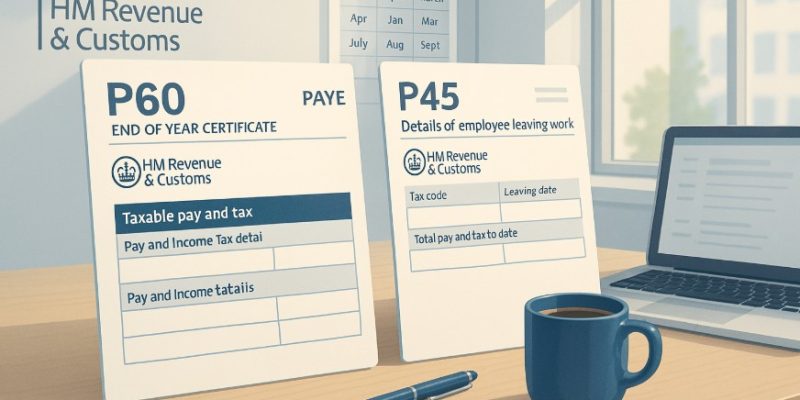
P60 vs P45 | What’s the Difference and Why It Matters?
When managing payroll and employee documentation, employers and employees alike will encounter a range of PAYE (Pay As You Earn) forms.
Two of the most essential—and sometimes confusing—are the P60 and P45. While they may seem similar at first glance, each serves a distinct purpose in the UK tax system and plays a vital role in maintaining accurate employment and payroll records.
This guide outlines the core differences between P60 and P45, when they’re used, what information they contain, and why they matter for tax, compliance, and employment history.
What Is A P45 And Why Is It Important?

A P45 is a document that employers are required to provide to employees when they leave a job.
It’s an important part of the PAYE (Pay As You Earn) system in the UK, helping ensure a smooth transition from one employer to another by carrying over the correct tax information.
The P45 includes information such as the amount of tax paid so far in the current tax year and the employee’s earnings up to their last working day.
This document is crucial because it prevents the employee from being taxed incorrectly at their new job. It allows the new employer to use accurate tax details and prevents the use of emergency tax codes.
In the past, a physical copy of the P45 was sent to HMRC, but this process has since been updated. Now, the data is submitted electronically through Real Time Information (RTI).
The departing employee is still provided with a printed or electronic copy of the form for their personal records and to share with their new employer.
Employers must process the final payroll before issuing a P45. Sometimes, this means the document is available only after the employee has left the organisation.
What Details Are Included On A P45 Form?
The P45 form includes the following details:
- Employee’s full name and National Insurance number
- Tax code at the time of leaving
- Total taxable earnings for the current tax year
- Total income tax deducted
- Employer’s PAYE reference number
One limitation of the P45 is that it does not include certain deductions such as:
- National Insurance contributions
- Pension contributions
Because of this, employees are advised to retain their final payslip, which contains this information. This can be important later, especially when checking employment history, retirement contributions or reconciling pay details.
For employers, the information on a P45 ensures that the incoming employee’s tax deductions are calculated accurately in their payroll system.
How to Obtain A P45?
To receive a P45, an individual must be leaving their job. This could be due to resignation, dismissal, redundancy, or even retirement.
Regardless of the reason for departure, every employer in the UK is legally obligated to provide a P45 to an employee who is leaving their position.
The P45 should be issued automatically as part of the employee’s final payroll process.
It is typically prepared and handed over or sent shortly after the final day of employment, once the last payslip has been processed. However, in some cases, employers may delay or overlook this step.
If an employee does not receive a P45, they have the right to request it. The employer cannot legally refuse to provide the document.
It is a statutory requirement under PAYE regulations, and the form serves a crucial function in helping the departing employee provide tax and income details to their next employer or claim any refunds from HMRC.
To summarise:
- You must have left your job to get a P45.
- It must be provided regardless of the reason for leaving.
- If it’s not received, request it directly from your employer.
- Employers are legally required to issue it and cannot refuse.
Employees should keep their P45 safe, as it contains information needed to ensure they are taxed correctly at their next job and for maintaining accurate personal tax records.
What Should You Do If An Employee Doesn’t Have A P45?

Sometimes, new employees do not have a P45. In such cases, employers must use a government-issued starter checklist. This checklist helps to gather the necessary tax information so that the new employee is not put on an incorrect tax code.
Here’s what to do if the P45 is missing:
- Ask the employee to complete a starter checklist. This can be generated via payroll software or downloaded from the GOV.UK website.
- Input the information from the checklist into your payroll system.
- Apply the temporary tax code based on the responses until HMRC sends an updated code or the employee provides a P45 later.
The starter checklist replaces the older P46 form and is now a standard part of onboarding employees without prior tax records for the current year.
Employers are legally required to provide a P45 when an employee leaves. It may be issued after the employee has left if payroll is processed post-departure.
How Long Should A P45 Be Kept?
Employers and employees should retain P45 documents for at least six years from the end of the tax year they relate to. This aligns with general record-keeping standards recommended by HMRC.
Although HMRC can only audit back six years in most cases, there are exceptional circumstances where checks can go back as far as twenty years. Holding onto P45s longer than the minimum requirement can help avoid complications in the event of a retrospective audit.
Key points to remember:
- Employers should store copies securely within their payroll records.
- Employees should keep P45s in their personal records for financial tracking and future job transitions.
- Old P45s from a prior tax year should not be used for payroll processing in the current year.
If a P45 is provided that relates to a different tax year, it must be disregarded and a starter checklist used instead.
What Is A P60 And When Is It Issued?

The P60 is a summary document issued to employees who are still working with their employer on 5 April, the final day of the UK tax year. It shows how much the employee earned and how much tax was deducted over the course of the full tax year.
A P60 is not issued when an employee leaves a job during the year. Instead, their tax summary up to that point is captured in the P45.
Employers are legally required to issue a P60 to each qualifying employee by 31 May. This can be done through digital or printed copies, depending on the company’s payroll system.
Employees may receive more than one P60 if they hold multiple jobs with different employers, provided they were employed in each job on 5 April.
The P60 is widely used as proof of income for a variety of purposes, including:
- Loan and mortgage applications
- Tax credit claims
- Universal Credit income verification
What Information Does A P60 Contain?
The P60 provides a complete picture of the employee’s tax-related details for the entire tax year. The form includes:
- Employee’s name and National Insurance number
- Tax year (running from 6 April to 5 April)
- Total earnings in the tax year
- Total income tax paid in the tax year
- National Insurance contributions for the current job
- Current tax code
- Employer’s PAYE reference number
What’s not included:
- Pension contributions
- Additional deductions (e.g. student loans, salary sacrifice items)
Because of these omissions, it’s recommended that employees keep their final payslips of the tax year, especially if they are contributing to workplace pension schemes.
Even though the information in the P60 is also visible in an individual’s personal tax account with HMRC, many financial institutions still ask for a physical or PDF version of the P60 as formal documentation.
How to Obtain A P60?
A P60 is issued to employees who are still in active employment on 5 April, the last day of the UK tax year.
Employers are required by law to provide a P60 by 31 May, either as a paper copy or electronically through a payroll system. This form summarises total earnings, income tax paid, and National Insurance contributions for the entire tax year.
Employees will receive one P60 per job they are still employed in on 5 April. If they have changed jobs during the year, the income from the previous employer (recorded on the P45) is included in the P60 issued by the current employer.
However, if an individual holds multiple jobs simultaneously and remains employed in each role as of 5 April, they will receive multiple P60s, one from each employer.
For company directors or business owners who receive a salary through payroll, it is important to issue a P60 to themselves as well, following the same process as for any other employee.
In cases where a P60 has been lost, employees can request a replacement from their current employer. Employers are legally required to retain copies of P60s for at least three years.
However, former employers are not obligated to keep a copy once the employee has left, so it’s essential to act quickly if a replacement is needed.
Key takeaways:
- Issued to employees still working on 5 April
- Must be provided by 31 May
- Available in paper or electronic format
- Multiple P60s are issued if holding multiple jobs
- Replacements can be requested from current employers only
Keeping your P60s safe is important for tax, financial planning, and proof of income.
What Are The Main Differences Between A P45 And A P60?
Though they both summarise earnings and tax information, the P45 and P60 are used in completely different circumstances. Below is a breakdown of their key differences:
| Feature | P45 | P60 |
| Issued When | When an employee leaves a job | At the end of the tax year (5 April) |
| Issued By | Former employer | Current employer |
| Purpose | Transfers tax info to new job and HMRC | Summarises yearly tax and income details |
| Covers | From start of tax year to leaving date | From 6 April to 5 April of current year |
| National Insurance Shown | Not included | Included for current employment |
| Applies To | Leavers during the tax year | Employees still employed on 5 April |
| Used For | Ensuring correct tax code in new job | Proving annual income for tax or loan purposes |
Both documents are essential and play different roles in payroll and employment documentation. They ensure accurate reporting to HMRC and serve as evidence of income and tax paid.
Why Do P45 And P60 Forms Matter For Payroll And Tax Compliance?

Both P45 and P60 forms are essential components of payroll processing in the UK and play a critical role in ensuring accurate tax compliance for both employers and employees.
Their importance goes far beyond routine paperwork — these documents form the backbone of the PAYE system and help avoid costly tax errors, penalties, or disruptions in employee income reporting.
From an employer’s perspective, issuing these forms correctly and on time is a legal requirement.
A P45 must be provided when an employee leaves their role, allowing the next employer to apply the correct tax code and avoid over- or under-taxing the individual.
Similarly, a P60 summarises an employee’s total earnings and tax deductions over the course of the tax year, which is essential for both the employee’s personal records and for satisfying HMRC’s annual reporting requirements.
Failure to issue these documents accurately can lead to a number of compliance issues including fines from HMRC, inaccurate payroll records, and employee dissatisfaction.
Employers who do not issue a P60 by the 31 May deadline could be investigated or penalised under PAYE legislation.
For employees, these forms are equally important. The P45 ensures a smooth transition when changing jobs, avoiding delays in pay or the risk of emergency tax deductions. The P60 serves as formal proof of income, often required for:
- Loan or mortgage applications
- Tax credit or Universal Credit claims
- Financial planning and pension tracking
These documents also help employees identify any discrepancies in their tax payments, and are critical if they need to claim a tax refund or correct errors with HMRC.
Conclusion
In conclusion, understanding the key differences between a P60 and P45 is essential for both employers and employees in the UK.
These forms play a crucial role in ensuring accurate tax reporting, smooth job transitions, and financial transparency.
Employers must handle them correctly to stay compliant with HMRC, while employees should retain them for personal records and future reference.
Whether leaving a job or closing the tax year, knowing when and how these forms apply makes payroll management much easier.
FAQs
What Should I Do If I Lost My P45?
If you’ve lost your P45, contact your former employer and request a replacement. If they cannot issue one, complete a starter checklist for your new job to avoid incorrect tax deductions.
Can I Get A P60 If I Changed Jobs During The Year?
Yes, you will receive a P60 from your current employer if you are still employed on 5 April. Previous employers would have given you a P45 upon leaving.
Do Self-Employed Individuals Get A P60 Or P45?
No. These forms are specifically for PAYE employees. Self-employed individuals file tax returns through the Self Assessment system.
Is A Digital P60 Valid For Loan Applications?
Yes, digital P60s are legally valid and accepted for loans, mortgages, and credit applications as long as they are official and unaltered.
Why Didn’t I Receive A P60 This Year?
You won’t receive a P60 if you weren’t employed on 5 April. You should, however, have received a P45 if you left your job before that date.
Are Employers Legally Required To Issue P45s?
Yes, employers are obligated to issue a P45 when an employee leaves their position, ensuring continuity of tax information for the next employer and HMRC.
Can I Use A P45 From A Previous Year?
No, P45s from prior tax years are not valid for current payroll processing. Instead, the employee must fill out a starter checklist.





